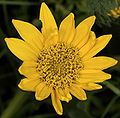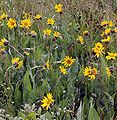Wyethia angustifolia
Wyethia angustifolia, Family: Asteraceae, Mule’s ears, California Compass-plant Narrowleaf Wyethia
Contents
Taxonomy
- Kingdom Plantae – Plants
- Subkingdom -Tracheobionta – Vascular plants
- Superdivision - Spermatophyta – Seed plants
- Division - Magnoliophyta – Flowering plants
- Class
- Subclass
- Order
- Family
- Genus
- Species
Description
General: Tap-rooted, leafy-stemmed perennial, the stems stout but lax, 2-9 dm. tall, the herbage covered with short, stiff, blunt hairs. Leaves: Leaves mostly entire, the basal ones enlarged, with narrow, elongate blades, 1.5-5 dm. long and 2.5-10 cm. wide, tapering at both ends; cauline leaves smaller and variable. Flowers: Heads usually solitary; involucral bracts lance-linear, in several series, herbaceous, with conspicuous hairs on the margins; rays 13-21, chrome-yellow, pistillate and fertile, 1.5-3.5 cm. long; disk flowers light yellow, perfect and fertile; receptacle broadly convex, chaffy throughout, the bracts clasping the achenes; pappus of petal-like appendages. Fruit: Achenes compressed-quadrangular
Bloom Period
- Flowering time: April-July
- Crop intervals: perennial
Distribution
From the east edge of the Columbia Gorge to the confluence of the Willamette river, south through the Willamette Valley of Oregon to California.
Habitat
- The plant prefers light (sandy) and medium (loamy) soils and requires well-drained soil.The plant prefers acid, neutral and basic (alkaline) soils..It cannot grow in the shade.It requires moist soil.
- Meadows and moist, open hillsides at low elevations.
Uses
- Raw stems used for food; seeds used for pinole (food) and dried for winter use; decoction of leaves used to reduces fever and induce perspiration; decoction of roots taken as an emetic; poultice of root lather used for lung problems and to draw blisters
- The seed can be dried, ground into a powder and used as a thickener in soups or can be added to cereal flours when making bread etc. Young leaves can be eaten raw. A lemon-yellow dye is obtained from the flowers. A gold to brass dye is obtained from the flowers, leaves and stems.
Propagation
Soak or stratify seed. Seeds should receive cool-moist stratification 90-120 days for proper germination
Seed
Sample From: 2010
Average Measurement: 7.6 x 2.5 x 2.2
Measurement Range: L: 7 - 8, W: 2 - 3, D: 1.9 - 2.5
Latitudinal Cross Section: circular ![]() Longitudinal Cross Section: elliptical
Longitudinal Cross Section: elliptical ![]()
Shape: Seed is long and narrow. Seed is narrow at hilum and broadens at opposite apex.
Additional Structures: Pappus that is attached at apex opposite hilum. Pappus fibers are broad at the base and are attached in a circular pattern. Pappus very brittle, and about ½ the length of the seed body.
Color: Hilum white, seed body medium brown, and pappus is tan to off-white.
Surface: Seed is matte with short bristles that are concentrated toward the pappus. Seed has many longitudinal ridges.
Photo Gallery
References
http://plants.usda.gov/java/nameSearch
http://www.wildflower.org/plants/result.php?id_plant=WYAN
http://biology.burke.washington.edu/herbarium/imagecollection.php
http://herb.umd.umich.edu/
http://pfaf.org/user/Plant.aspx?LatinName=Wyethia+angustifolia


